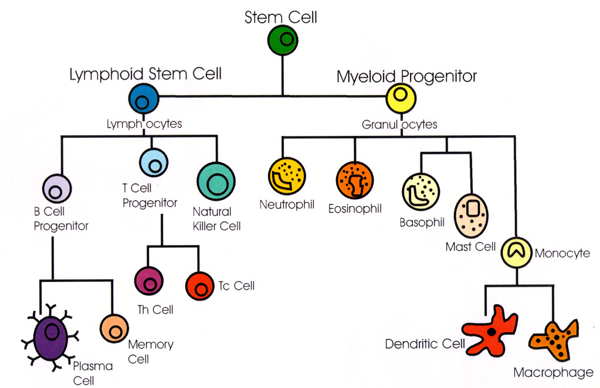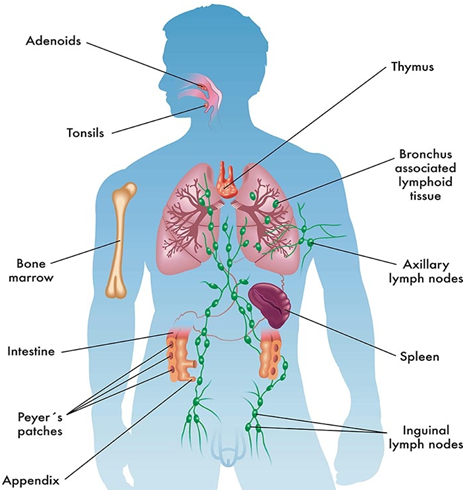All the cells of the immune system inclusive of blood cells originate from the bone marrow during haematopoiesis from progenitor haematopoietic stem cells. Haematopoiesis is simply defined as the biological process involved in the formation of blood cells (i.e. white blood cells, red blood cells and platelets) and other cellular components of blood particularly the immune system cells such as the B and T cells in the bone marrow. During haematopoiesis, progenitor haematopoietic stem cells in the medullar of the bone or bone marrow proliferate into progenitor erythroid cells, myeloid cells and lymphoid cells.
The erythroid cells proliferate into erythrocytes or oxygen-carrying red blood cells (RBCs) and reticulocytes (i.e. immature RBCs) while the myeloid cells proliferate into myelocytes or myelocyte cells (e.g. macrophages, granulocytes and megakaryocytes) which play critical roles in both adaptive and innate immune response. The lymphoid cells proliferate mainly into lymphocytes which include T cells and B cells or white blood cells (WBCs).
The immune system is a complex system or network that comprises of several cells and organs and other immunological products (e.g. antibodies) which work cooperatively to protect the body from infectious diseases/infections as well as from disease causing pathogenic microorganisms. Every living animal (inclusive of humans) are inundated and fashioned with these complex networks of cells and organs that help them to fight against the invasion and colonization of the body by pathogenic microorganisms.
These immune system cells are found dispersed in every part of the body; and they mount immunological actions to counteract the negative consequences of invading antigens or pathogens. The immune system is man’s natural mechanism of keeping infectious diseases at bay; and when the immune system is compromised (e.g. through malnutrition, stress and the presence of a debilitating disease like HIV/AIDS); the individual becomes exposed to plethora of infectious disease agents that invades the body, colonizes it and cause disease/infections.
Thus the effectiveness of the immune system of the host is critical to the prevention of invasion and colonization of the body by pathogenic microorganisms. Lymphoid cells, lymphocytes, phagocytes, macrophages, dendritic cells, memory B cells, plasma cells, granulocytes, megakaryocytes, basophils, eosinophils, neutrophils, null cells and monocytes amongst others are some of the cells of the immune system; and these cells become mobilized to respond to any invading antigen or pathogen that threatens the normal physiological conditions of the host.
LYMPHOCYTES
Lymphocytes are mononuclear leukocytes that mediate both humoral or antibody-mediated immunity and cell-mediate immunity. B cells, T cells and natural killer (NK) cells are the main types of lymphocytes that make up the immune system (particularly the adaptive or specific immunity). The lymphocytes which can also be known as lymphoid cells (i.e. the B and T cells) are the major cells of the entire immune system; and they are mainly responsible for the key attributes of the adaptive or specific immunity such as discrimination between self and non-self molecules, specificity, diversity and immunological memory amongst other characteristics that the specific immune system is known for. While “B” lymphocytes derive their name from their site of maturation (i.e. the Bursa of Fabricius in birds and bone marrow in mammals/humans), the “T” cells also derive their own name from their site of maturation; and in this case the thymus.
B cells can recognize soluble or free antigens via their B cell receptors (BCRs) unlike T cells whose T cell receptors (TCRs) cannot recognize free antigens except for those antigens that have been bound, processed and presented by one of the MHC molecules (e.g. Class I MHC or Class II MHC molecules). Class I MHC molecules present antigenic peptide molecules to cytotoxic T cells (TC cells) which expresses CD8 receptors/membrane molecules while Class II MHC molecules present antigenic peptide molecules to helper T cells (TH cells) which expresses CD4 membrane molecules.
And aside the TC cells or CD8+ cells and TH cells or CD4+, other subpopulations of T lymphocytes with unique immunological functions also exist. B cells are lymphocytes whose most important function in the immune system is to secrete antibody-producing plasma cells following their specific interaction with antigens or foreign body. The primarily mature in the bone marrow; and B lymphocytes or cells also differentiate into memory B cells that remain quiescent and parade the body for a second appearance of similar antigen. B cells are the main mediators of humoral or antibody-mediated immunity (AMI).
T cells are lymphocytes that mature mainly in the thymus after production in the bone marrow; and they express T cell receptors (TCRs) for the recognition of antigenic peptide molecules displayed by major histocompatibility complex (MHC) molecules. They are the main mediators of cell-mediated immunity (CMI); and T cells or lymphocytes undergo differentiation after activation into effector cells especially T helper (CD4+) cells and T cytotoxic (CD8+) cells amongst others.
CD8+ cells are mainly responsible for killing tumor cells, virus-infected cells, transplant cells, and parasites; and they also down-regulate the immune system as well as recognize peptide molecules displayed by Class I MHC molecules. CD4+ cells recognize and process peptide molecules displayed by Class II MHC molecules; and they secrete immunological molecules that help to stimulate other components of the immune system. Immune system cells develop through a process known as hematopoiesis in the bone marrow (Figure 1).

PHAGOCYTES
Phagocytes are generally known as bacteria-eating cells. They engulf microbial cells (particularly pathogenic bacteria) through a process known as phagocytosis, and this leads to the degradation of the engulfed bacteria. Macrophages, neutrophils and eosinophils are examples of phagocytic cells.
MACROPHAGES
Macrophages are multi-functional immune system cells that have a variety of immunological functions. For example, macrophages act as antigen presenting cells and they also process antigens and make them readily available for phagocytosis. Macrophages mediate phagocytosis and they also secrete cytokines as well as mediate antibody-dependent cell-mediated cytotoxicity (ADCC).
Macrophages are found in various tissues of the body where they express a variety of immunological functions especially phagocytosis. Kupffer cells and histiocytes are macrophage-like cells found in the liver and connective tissues respectively. In the lungs and kidneys, alveolar macrophages and mesangial cells respectivelyare the macrophage-like cells that provide immunological functions. Microglial cells and osteoclasts are the macrophage-like cells that are found in the brain and bone respectively.
DENDRITIC CELLS
Dendritic cells (DC) are cells of the immune system that mainly act as antigen presenting cells (APCs); and they comprises of langerhans cells found underneath the skin. They play critical roles in both innate and adaptive immune response. Dendritic cells are found in the blood, spleen, lymph nodes and thymus; and they are professional APCs like the macrophages. They basically process and present antigenic peptide molecules to T helper (CD4+) cells because they express receptors for Class II MHC molecules.
MEMORY B CELLS
Memory B cells are unique class of B cells that remain inert but viable in the blood circulation for a long period of time; and they are capable of rapid activation upon the encounter of a previously invading pathogen or antigen in the body. Memory B cells play critical role in secondary immune response; and each time the immune system is exposed to a particular antigen and produce effector B and T cells to counter the debilitating effect of the invading pathogen, the immune system also produces several memory B and T cells which police the entire blood circulation in search of similar antigens that invades the body in the future. These memory B and T cells mount a rapid secondary immunological response that activates and mobilizes other components of the immune system into action.
PLASMA CELLS
Plasma cells are antibody-secreting cells produced by immunocompetent B cells. They are short-lived in the blood circulation but plasma cells produces large amount of specific antibodies during their short lifespan. During their short lifespan, plasma cells secrete large amount of immunoglobulins that are specific for each of the antigenic determinant sites or epitopes of antigens that invades the body.
GRANULOCYTES
Granulocytes are a type of white blood cells (WBCs) or leukocytes that contain granules in their cytoplasm. Examples of granulocytes include basophils, neutrophils and eosinophils. Granulocytes are different from non-granular leukocytes (e.g. monocytes and lymphocytes) which do not contain granules in their cytoplasm. The granulocytes are produced in the bone marrow; and they specifically fight invading pathogens or antigens in the body.
MEGAKARYOCYTES
Megakaryocytes are multi-nucleated large cells that are produced in the bone marrow with the sole biological function of producing platelets or thrombocytes, blood-clotting factors.
BASOPHILS
Basophils are granulated WBCs or leukocytes; and they usually contain vasoactive substances such as histamine produced during allergic reactions in the body and heparin, an anticoagulant. They are mainly present in the blood circulation where they initiate inflammatory reactions following the body’s invasion by pathogens or antigens. Upon encountering an antigen, immunoglobulins (especially immunoglobulin E, IgE) through their FC region binds to or cross-links with the basophils; and this binding leads to the release of vasoactive substances or pro-inflammatory mediators (e.g. histamine) which results in hypersensitivity reaction in the body. Basophils stain blue when stained with basic dyes; and this aid in their identification in blood specimens in the laboratory.
EOSINOPHILS
Eosinophils are a type of granulocytes that can easily be stained with eosin, a red-crystalline dye. They have phagocytic properties; and unlike other types of granulocytes the eosinophils can phagocytose or engulf bacteria through the process of phagocytosis. Eosinophils also play critical roles in mounting immunological response during parasitic or nematode infection. Eosinophils stain red when stained with eosin.
NEUTROPHILS
Neutrophils are a type of granulocytes which exhibit both phagocytic and inflammatory immunological response. They stain neutral or pale pink when stained with Wright’s stain. Neutrophils are also known as polymorphonuclear leukocytes (PMNs); and they are generally known as bacteria-eating granulocytes. They are bacteriocidal in action.
NULL CELLS
Null cells are immature B cells that have not encountered an antigen. They can also be called naïve B cells or lymphocytes.
MONOCYTES
Monocytes are nucleated leukocytes that exhibit phagocytic action following the invasion of antigens or pathogenic bacteria into the body.
REFERENCES
Abbas A.K, Lichtman A.H and Pillai S (2010). Cellular and Molecular Immunology. Sixth edition. Saunders Elsevier Inc, USA.
Actor J (2014). Introductory Immunology. First edition. Academic Press, USA.
Alberts B, Bray D, Johnson A, Lewis J, Raff M, Roberts K and Walter P (1998). Essential Cell Biology: An Introduction to the Molecular Biology of the Cell. Third edition. Garland Publishing Inc., New York.
Bach F and Sachs D (1987). Transplantation immunology. N. Engl. J. Med. 317(8):402-409.
Barrett J.T (1998). Microbiology and Immunology Concepts. Philadelphia, PA: Lippincott-Raven Publishers. USA.
Jaypal V (2007). Fundamentals of Medical Immunology. First edition. Jaypee Brothers Medical Publishers (P) Ltd, New Delhi, India.
John T.J and Samuel R (2000). Herd Immunity and Herd Effect: New Insights and Definitions. European Journal of Epidemiology, 16:601-606.
Levinson W (2010). Review of Medical Microbiology and Immunology. Twelfth edition. The McGraw-Hill Companies, USA.
Roitt I, Brostoff J and Male D (2001). Immunology. Sixth edition. Harcourt Publishers Limited, Spain.
Zon LI (1995). Developmental biology of hematopoiesis. Blood, 86(8): 2876–91.
Discover more from #1 Microbiology Resource Hub
Subscribe to get the latest posts to your email.


